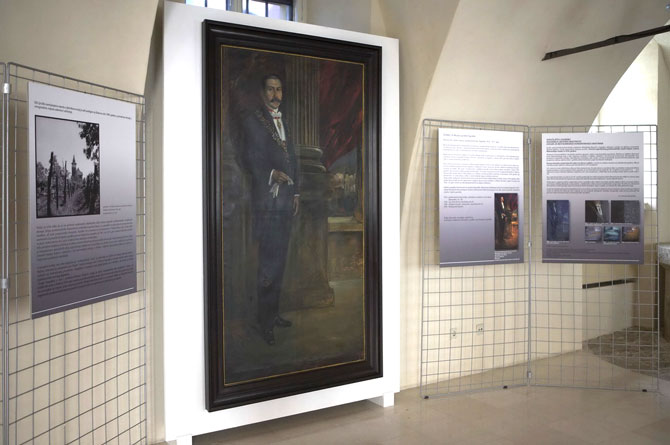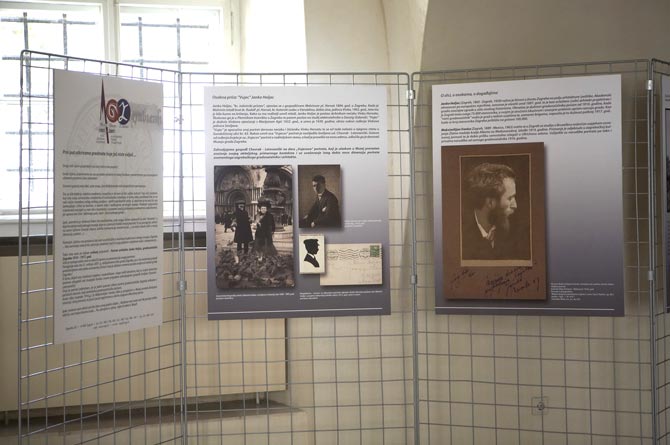An exhibition within the “Object of the Month” campaign on the occasion of the centennial of Zagreb City Museum
Exhibition concept: Željka Kolveshi
Without donors, a museum would be incomparably poor, the museum holdings would be much more modest and, no less importantly, without that two-way communication going from museum to donor to visitor and back again, through which we present the heritage with the accompanying story and the data about the origins of the objects that are necessary for trustworthy museological interpretation.
 Among the many donators during the One Hundred Years of the Museum, which we mention with gratitude, on this occasion we would like to present the gift of Mrs Smiljana Chavrak-Letovanički of Zagreb. In January 2005 she donated to us a valuable family heirloom painting. At the same time, Mrs Chavrak made available to us photographs and documents from the family archives and conveyed to us invaluable information without which it would not have been feasible to reconstruct the life story of this painting, its origins, its owners and when it was used:
Among the many donators during the One Hundred Years of the Museum, which we mention with gratitude, on this occasion we would like to present the gift of Mrs Smiljana Chavrak-Letovanički of Zagreb. In January 2005 she donated to us a valuable family heirloom painting. At the same time, Mrs Chavrak made available to us photographs and documents from the family archives and conveyed to us invaluable information without which it would not have been feasible to reconstruct the life story of this painting, its origins, its owners and when it was used:
1916: Mayor Janko Holjac, villa at 8, Bukovac, Zagreb
1939: Vinko Horvat, BEng (his nephew), 63 Gundulićeva
1986: Smiljana Chavrak-Letovanicki née Horvat (daughter of Vinko), 63 Gundulićeva
2005: Zagreb City Museum
This new acquisition is of exceptional importance for the Zagreb City Museum, for two reasons. Firstly, this is the only known painted portrait showing the Zagreb mayor in his official robes with his chain of office. The City council made a decision commissioning the chain in 1902, and from that time it was in official use until it was given into the keeping of the museum after 1945.
Janko Holjac (Zagreb, 1865 – Zagreb, 1939) was an important figure in the life of Zagreb in both architecture and politics. Academy trained according to fully European criteria as architect, he designed and built some important edifices in the style of High Historicism. In this portrait, Holjac clearly wanted to have the two sides of his professional and social achievements immortalised. The role of mayor is without any question symbolised by the chain of office, while in the background is the Basilica of the Heart of Jesus with its monastic institution in Palmotićeva street. This great contemporary Jesuit complex was built according to a Holjac design from 1901 to 1913, and, judging by this portrait, he felt it should be displayed prominently as his masterpiece.
The second reason is that this is a portrait by painter Maksimilijan Vanka (Zagreb, 1889-Mexico, 1963), and was created in 1916; this is a painting that has only now been added to the artist’s catalogue, and it was the first done in the large format in which, from 1924-1925 onwards he was to create a number of paintings that characterise his oeuvre.
The historical presentation of the painting includes an interpretation of the hole or damaged spot on the canvas on the subject’s right knee. The damage was produced by no other than Holjac, wounding himself, when he was careless in handling a small cannon that he had acquired to frighten burglars with. Another anecdote connected with Mayor Holjac relates to an incident that might have had much more severe consequences; on an official trip of Krakow, the mayor’s chain of office was lost, but luckily it turned out to have been only mislaid, and was restored. It might have happened that the only Zagreb mayor to have a portrait with the chain of office was the only one ever to lose it.
We thank Mrs Chavrak-Letovanički very much indeed for the gift of her uncle’s portrait, which, now in the museum, has outgrown its original, family, primary context, and while this is respected, it has taken on an extra manifest dimension, that of a celebrated Zagreb mayor and architect.
Željka Kolveshi
Pictures from the exhibition


photo Miljenko Gregl, ZCM

